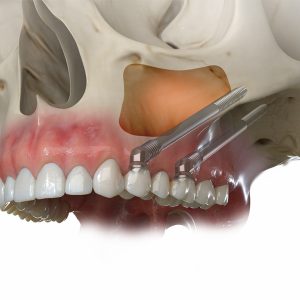Zygomatic implants are special dental implants for patients with severe loss of the upper jaw bone. These implants are not conventional; they are anchored in the zygomatic bone, which provides a supporting base for teeth prostrations. It is used for immediate load and rehabilitation immediate restoration and facial aesthetics, and it is a solution for a hopeless situation in dental rehabilitation.
Zygomatic implants are an invention made in response to the many limitations of dental surgery, hence revolutionizing the field. Just as in its history, zygomatic implants overcome the limitations of jawbone density differences and complicate the surgery process. Therefore, this approach develops new surgery techniques based on the change in dental prosthetics security.
The Need for Zygomatic Implants
- Traditional Implants vs. Zygomatic Implants: Zygomatic implants benefit patients in need of dental restoration, yet who have deficient jawbone. They constitute a sturdy alternative that takes advantage of the strong nature of the zygomatic bone to sustain dental prostheses, thereby negating the necessity for intricate grafting. They are increasingly being utilized across dental practice and have transformed the treatment procedures, and outcomes, providing more graft-free treatment with improved stability, early loading possibilities, and quality of life for the users.
- Candidate Profile: Zygomatic implants are used when patients have extensive bone loss in the upper jaw and are not viable candidates for the conventional implant procedure. Zygomatic implants have revolutionized the implantology industry as they allow for robust fixation in the zygomatic bone allowing patients to avoid bone resorption and undergo quick dental restoration.
How Zygomatic Implants Work

- Anatomy of the Implant: Zygomatic implants are dental implants that are longer than traditional dental implants. Their length enables them to anchor into the zygomatic bone. This is essential in dental surgery since it provides a base for prosthetic teeth that is not affected by an insufficient amount of the upper jawbone which is common when it comes to dental implants.
- Surgical Procedure: The process of placing Zygomatic implants starts with pre-surgical assessments that include the 3D imaging of the zygoma to gauge the quality and shape of the bone. However, the main procedures of surgery involve the placing of implants into the zygomatic bone, taking advantage of their length for primary stability. The key implication of this approach is related to the benefits of zygomatic implants, which result in reduced time in surgery and minimized rehabilitation period due to the immediate load.
- Advantages over Traditional Implants: One of the greatest benefits provided by zygomatic implants is the elimination of one of the most cumbersome parts of traditional dental implants: the bone graft. A bone graft is required in virtually all traditional dental implant situations to create a suitable substrate in which the implants can be anchored. This additional procedure is laborious for both the medical staff and the patient, but with zygomatic implants, it is not necessary . Thus, other treatment times, the experience of discomfort, and the patient’s almost immediate function restoration upon receiving zygomatic implants are significantly reduced.
Recovery and Aftercare

- Post-Surgery Recovery: Zygomatic implant surgery recovery involves swelling, bruising and discomfort is common and can be easily controlled with medications. While the initial healing phase takes several weeks, complete osseointegration may take several months. It is important to follow all post-op care instructions to achieve the best healing outcomes and ensure implant retention.
- Aftercare Tips: To guarantee a longer lifespan of Zygomatic implants and avoid any complications, one should adopt a careful oral hygiene routine that involves daily brushing, flossing, and rinsing with an antimicrobial solution. Furthermore, one should not miss any follow-up consultation for professional cleanings and check-ups. Additionally, during the initial postoperative period, one should avoid hard and sticky foods and smoking cessation, which impairs healing and lowers implant survival.
Risks and Considerations
- Potential Complications: Short-term complications are common with the use of Zygomatic implants and include sinus infections, bruising, swelling, and some degree of pain. Long-term risks may include implant failure, nerve damage, or possible sinus concerns. The key to successful implant integration and maintenance is to take appropriate procedural steps and ensure proper postoperative care.
- Making an Informed Decision: It is essential to speak with a dental specialist before deciding on Zygomatic implants to get a complete view of these implants’ risks and rewards. The specialist will assess your history of dentistry and your needs, leading you to the decision. This will help you be successful with your implants in years to come.
The Future of Zygomatic Implants
- Technological Advances: While the current trends in Zygomatic implants are oriented on minimally invasive approaches and digital planning to guarantee the most accurate position, future developments may involve bioactive surfaces to the organic tissues, 3D printed custom implants, and combined use with regenerative medicine, thus significantly boosting the success rate and the affected area of the dental application.
- Expanding Applications: It is also possible that there may be an increase in the use of Zygomatic implants prompted by the wider use of dental technology and knowledge regarding the value offered by long implants in complex cases. With more experience and availability of the skills, the method will likely be used in more minor bone loss cases and in combination with novel regenerative dental innovations to improve patient outcomes.
Conclusion
Zygomatic implants are a game-changer in modern dentistry. They provide a solution where bone loss is too substantial for traditional systems to work. They eliminate the need for bone grafting, facilitate shorter treatment duration, and achieve instant function and aesthetics. They ascertain one of the most significant headways in innovative dental implant engineering. If you need dental restoration and would like to inquire more about Zygomatic Implants, make an appointment immediately! Visit https://drgagansabharwal.com or any Dental Implant specialist to get started on the path to a whiter, healthier smile!
